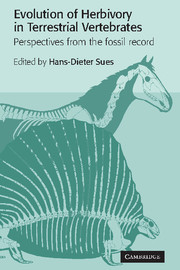Book contents
- Frontmatter
- Contents
- List of contributors
- Preface
- 1 Herbivory in terrestrial vertebrates: an introduction
- 2 Herbivory in late Paleozoic and Triassic terrestrial vertebrates
- 3 Prosauropod dinosaurs and iguanas: speculations on the diets of extinct reptiles
- 4 The evolution of sauropod feeding mechanisms
- 5 Plant-eaters and ghost lineages: dinosaurian herbivory revisited
- 6 Dental constraints in the early evolution of mammalian herbivory
- 7 Patterns in the evolution of herbivory in large terrestrial mammals: the Paleogene of North America
- 8 Origin and evolution of the grazing guild in Cenozoic New World terrestrial mammals
- Taxonomic index
- Subject index
1 - Herbivory in terrestrial vertebrates: an introduction
Published online by Cambridge University Press: 22 October 2009
- Frontmatter
- Contents
- List of contributors
- Preface
- 1 Herbivory in terrestrial vertebrates: an introduction
- 2 Herbivory in late Paleozoic and Triassic terrestrial vertebrates
- 3 Prosauropod dinosaurs and iguanas: speculations on the diets of extinct reptiles
- 4 The evolution of sauropod feeding mechanisms
- 5 Plant-eaters and ghost lineages: dinosaurian herbivory revisited
- 6 Dental constraints in the early evolution of mammalian herbivory
- 7 Patterns in the evolution of herbivory in large terrestrial mammals: the Paleogene of North America
- 8 Origin and evolution of the grazing guild in Cenozoic New World terrestrial mammals
- Taxonomic index
- Subject index
Summary
Introduction
Understanding the ecological attributes of extinct organisms has long been a major research topic in paleobiology, dating back to the pioneering work of the French paleontologist Georges Cuvier in the early nineteenth century. Inferences concerning the ecology of an extinct organism can be based on functional interpretation of its structure, by analogy with present-day relatives, or from the sedimentary context and distribution of fossil remains referable to this taxon (Wing et al. 1992). Traditionally, functional morphology has been the most widely used of these approaches. It basically relies on the analysis of organisms as simple machines with functional attributes that can be inferred from the physical properties of their bodies as well as from their shape and size. Chemical analyses of hard tissues (such as extraction of preserved stable carbon isotopes) increasingly are providing significant new data for inferring diet in extinct animals. In recent years, researchers have developed various procedures for linking inferences concerning function in fossils to phylogenetic analyses, increasing confidence in the robustness of these reconstructions (see various papers in Thomason [1995]).
Herbivory, the consumption of plant tissues, is a widespread phenomenon among terrestrial vertebrates. It has frequently and independently evolved in many lineages of amniotes during the last 300 million years or so. Some major groups of herbivorous tetrapods, such as ungulate mammals and ornithischian dinosaurs, attained great abundance and taxonomic diversity. Indeed, the advent of herbivory among land-dwelling tetrapods was one of the key events in the history of life on land.
- Type
- Chapter
- Information
- Evolution of Herbivory in Terrestrial VertebratesPerspectives from the Fossil Record, pp. 1 - 8Publisher: Cambridge University PressPrint publication year: 2000
- 6
- Cited by



